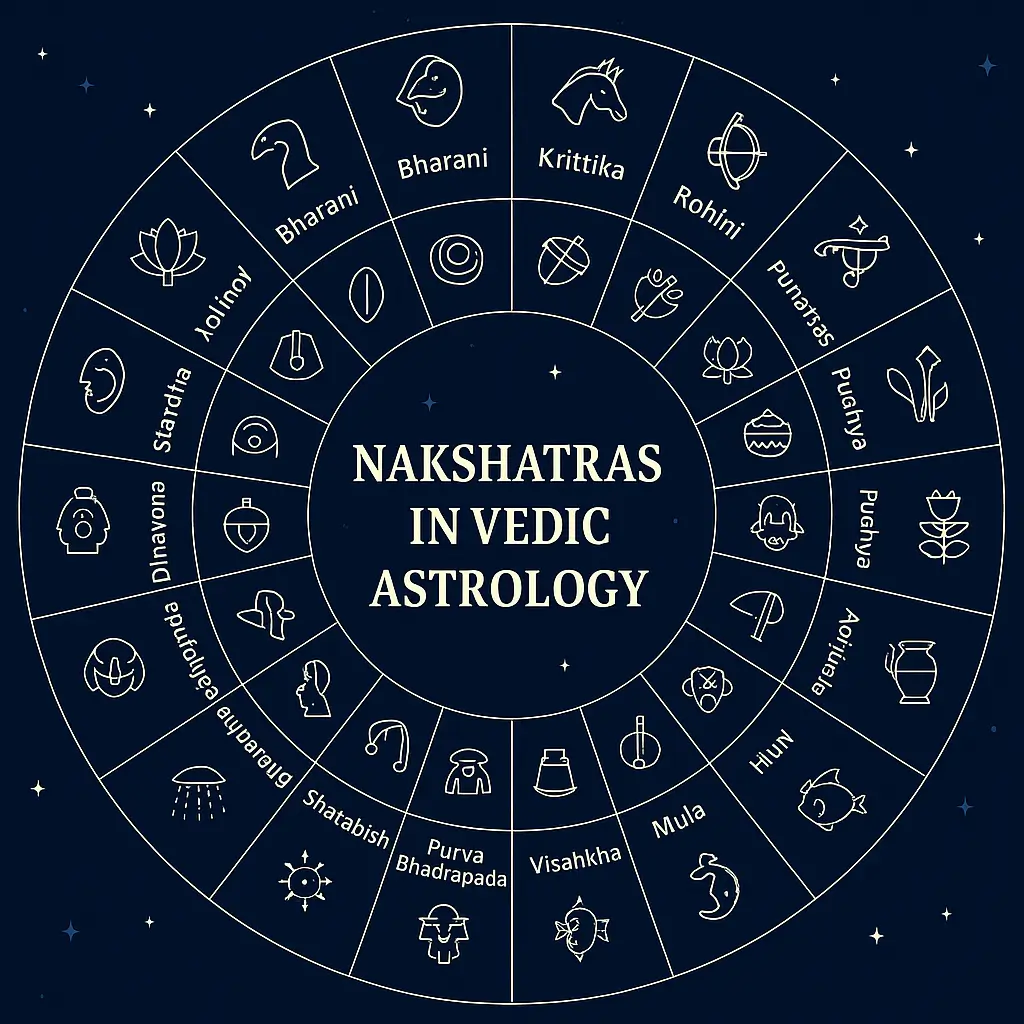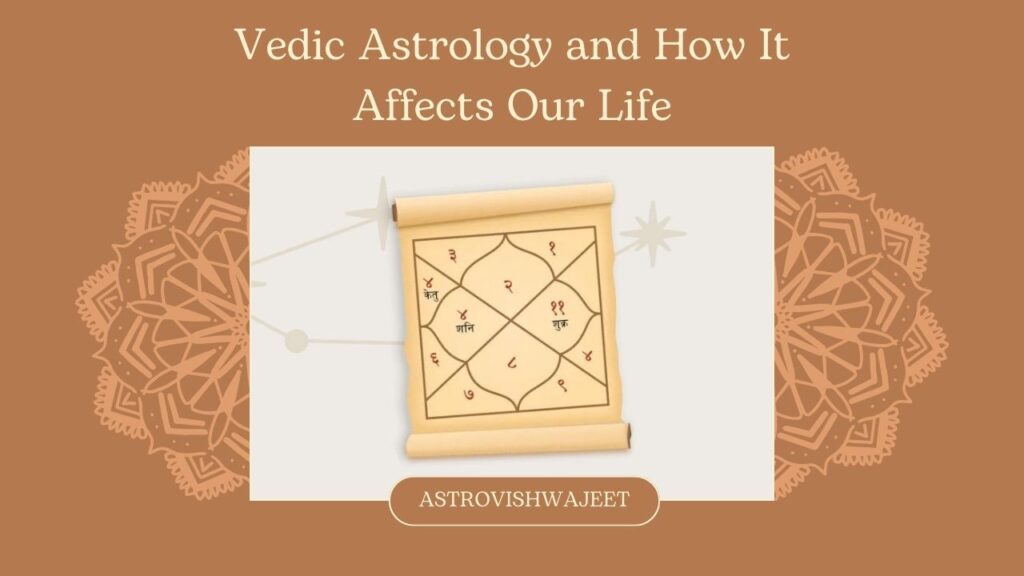Vedic astrology, or Jyotish Shastra, is a profound and ancient system of divination that offers deep insights into human life and destiny. One of its most foundational concepts is the Nakshatra, or lunar mansion. While most people are familiar with the 12 zodiac signs (Rāśis), fewer are aware that the zodiac is further subdivided into 27 Nakshatras, each with its unique energy, symbolism, and impact.
In Vedic astrology, Nakshatras form the very soul of prediction. They are the celestial DNA imprinted upon each individual at birth. By understanding Nakshatras, one can gain detailed insights into personality, behavior, destiny, relationships, and spiritual evolution.
What are Nakshatras?
The term Nakshatra comes from the Sanskrit roots “Naksha”, meaning map, and “Tra”, meaning to guard. Hence, Nakshatras are the guardians of the sky, mapping out the journey of the Moon and influencing life on Earth.
The full 360° circle of the zodiac is divided into:
- 12 zodiac signs (Rāśis) – each covering 30°
- 27 Nakshatras – each covering 13°20′ (360° ÷ 27)
The Moon, being the fastest moving celestial body, passes through each Nakshatra approximately every day. Therefore, a person’s birth Nakshatra (Janma Nakshatra) is determined by the Nakshatra the Moon occupied at the time of their birth.

The 27 Nakshatras and Their Significance
Each Nakshatra has a ruling deity, planetary ruler, symbol, and shakti (power). Here is a brief overview:
| # | Nakshatra | Symbol | Ruling Deity | Planet |
|---|---|---|---|---|
| 1 | Ashwini | Horse’s head | Ashwini Kumars | Ketu |
| 2 | Bharani | Yoni | Yama | Venus |
| 3 | Krittika | Razor/blade | Agni | Sun |
| 4 | Rohini | Chariot | Brahma | Moon |
| 5 | Mrigashira | Deer head | Soma | Mars |
| 6 | Ardra | Tear drop | Rudra | Rahu |
| 7 | Punarvasu | Bow and quiver | Aditi | Jupiter |
| 8 | Pushya | Cow’s udder | Brihaspati | Saturn |
| 9 | Ashlesha | Serpent | Naga | Mercury |
| 10 | Magha | Royal throne | Pitris | Ketu |
| 11 | Purva Phalguni | Swinging hammock | Bhaga | Venus |
| 12 | Uttara Phalguni | Bed/cot | Aryaman | Sun |
| 13 | Hasta | Hand | Savitar | Moon |
| 14 | Chitra | Jewel | Tvashtar | Mars |
| 15 | Swati | Coral or sword | Vayu | Rahu |
| 16 | Vishakha | Archway | Indra & Agni | Jupiter |
| 17 | Anuradha | Lotus | Mitra | Saturn |
| 18 | Jyeshtha | Umbrella or earring | Indra | Mercury |
| 19 | Mula | Root | Nirriti | Ketu |
| 20 | Purva Ashadha | Fan | Apas | Venus |
| 21 | Uttara Ashadha | Elephant tusk | Vishwadevas | Sun |
| 22 | Shravana | Ear | Vishnu | Moon |
| 23 | Dhanishta | Drum | Vasus | Mars |
| 24 | Shatabhisha | 100 physicians | Varuna | Rahu |
| 25 | Purva Bhadrapada | Sword | Aja Ekapada | Jupiter |
| 26 | Uttara Bhadrapada | Twin fishes | Ahir Budhnya | Saturn |
| 27 | Revati | Fish | Pushan | Mercury |
Each Nakshatra brings its unique energies and karmic lessons, influencing personality, mental tendencies, emotional nature, and destiny paths.
Nakshatra and Personality Traits
The Nakshatra in which the Moon is placed at birth plays a pivotal role in shaping one’s mind and emotional character. Let’s take a few examples:
- Ashwini natives are energetic, fast, pioneering, and healing-oriented. Ruled by Ketu and symbolized by horse’s head, they initiate things quickly but may lack patience.
- Rohini natives are artistic, sensual, and nurturing, with a deep love for beauty and luxury.
- Ardra natives, under the influence of Rudra and Rahu, can be intense, transformative, and emotionally turbulent. They go through cycles of destruction and renewal.
- Magha people carry ancestral pride, leadership qualities, and a royal demeanor.
This is just a sample; each Nakshatra has dozens of layers of interpretation based on Pada (quarters), planetary conjunctions, and house placements.
Pada – The Four Quarters
Each Nakshatra spans 13°20′, and is further divided into four padas (quarters) of 3°20′ each. These quarters map onto the Navamsa chart, which adds further layers of meaning.
For example:
- Pushya Nakshatra has 4 padas, and each pada maps to a different zodiac sign in the Navamsa.
- A person with Moon in Pushya Pada 1 (Cancer Navamsa) will have emotional and nurturing traits.
- If in Pushya Pada 4 (Libra Navamsa), the native will show more diplomacy and balance.
Understanding the pada gives deeper insight into career, marriage, and spiritual tendencies.
Nakshatra Lords and Their Influence
Each Nakshatra is ruled by a planet. These Nakshatra lords affect the way that specific energies are expressed.
- If a person has Moon in Bharani, which is ruled by Venus, the person may show traits of love, creativity, and beauty.
- A person with Moon in Mula, ruled by Ketu, may be spiritually inclined but experience detachment and loss in early life.
Also, planetary Dasha periods (Vimshottari Dasha) are based on the Nakshatra the Moon occupies at birth. For example, if the Moon is in Ashwini, the first Dasha will be of Ketu, followed by Venus, Sun, etc.
This Dasha system governs the timing of events in life and is essential in predictive astrology.
Nakshatras in Relationships and Compatibility
Nakshatras play a vital role in match-making (Kundli Milan). One of the primary systems used is Ashtakoota Guna Milan, which evaluates compatibility based on:
- Dina (daily activities)
- Gana (temperament)
- Nadi (health/genes)
- Yoni (sexual compatibility)
- Rashi, Rajju, Vedha, and more
Some Nakshatra combinations are highly compatible, while others can create conflict or health issues in marriage.
For instance:
- Rohini and Mrigashira often form a beautiful romantic pairing.
- Ashlesha and Magha can be challenging due to ego clashes and emotional complexity.
Modern Vedic astrologers also analyze Venus and Mars Nakshatras for love life and Moon and Lagna Nakshatras for long-term bonding.
Nakshatra Remedies and Rituals
Every Nakshatra has a presiding deity, and sometimes, the qualities of a particular Nakshatra may be too dominant or challenging. In such cases, Vedic astrologers suggest specific remedies:
- Mantras – Chanting the associated deity’s mantra (e.g., “Om Ketave Namah” for Ashwini/Ketu).
- Charity and Puja – Performing rituals or donations on specific Nakshatra days.
- Wearing Gemstones – Based on the Nakshatra lord and Dasha lord (with caution).
- Fasting on Nakshatra Days – Observing fasts on one’s Janma Nakshatra day or performing abhishekam.
These remedies help align the native’s energy with the cosmic flow and reduce suffering.
Nakshatra and Spiritual Evolution
Nakshatras are not just tools for mundane prediction—they offer profound insights into spiritual paths.
- Ashwini initiates healing and spiritual awakening.
- Rohini represents creation and devotion to beauty and nature.
- Mula, ruled by Ketu, breaks attachments and pushes one to the root of truth.
- Revati, the final Nakshatra, symbolizes the end of the cycle and return to divine source.
Thus, Nakshatras trace the soul’s journey from inception to liberation (Moksha), making them a spiritual roadmap.
Nakshatras and Career Guidance
Nakshatra placement of planets like the Sun, Mercury, Mars, and 10th house lord can reveal one’s ideal career path.
- Ashlesha – Great for psychology, research, occult sciences.
- Dhanishta – Music, dance, fame, sports.
- Chitra – Architecture, design, craftsmanship.
- Pushya – Teaching, healing, leadership roles.
The Nakshatra of the Moon shows mental inclination, while Ascendant Nakshatra reveals behavioral expression. The Dasha lord’s Nakshatra further modifies the timing and nature of professional growth.
Important Nakshatra-based Concepts in Astrology
- Abhijit Nakshatra: A hidden 28th Nakshatra between Uttarashada and Shravana (11°06′ to 14°10′ Capricorn). Auspicious for victory, success, and overcoming obstacles.
- Gandanta: Occurs when planets lie between the junctions of water and fire signs (Pisces-Aries, Cancer-Leo, Scorpio-Sagittarius). These points (last 3°20′ of a water sign and first 3°20′ of a fire sign) are spiritually intense and transformative.
- Tara Bala and Chandra Bala: Used for Muhurta (electional astrology) based on favorable/unfavorable Nakshatras for the Moon.
- Janma Nakshatra Dosha: Certain combinations, like having birth in Ashlesha, Mula, Jyeshtha, etc., require special rituals at birth to mitigate karmic burden.
Conclusion
Nakshatras are the pulse of Vedic astrology, offering detailed insights far beyond the 12 zodiac signs. They help astrologers decode the subtle layers of karma, destiny, and character. Whether it’s understanding life purpose, choosing the right career, finding the right partner, or navigating spiritual growth, Nakshatras provide a nuanced map of the soul’s journey.
By studying Nakshatras and aligning with their rhythms, we move closer to self-awareness, harmony, and liberation.


